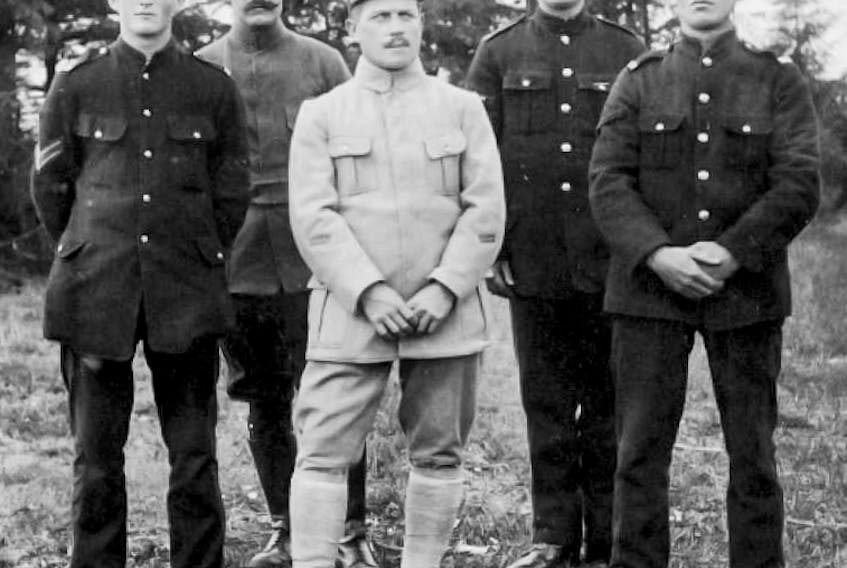Walking through the Royal Newfoundland Regiment Museum, you get a feeling military and service is important to the people of this province.
From the First 500 who signed up to serve King and Country, to those who have enlisted and fight all over the world today, Newfoundlanders and Labradorians know what it feels like to have great successes and suffer great losses.

Many of those young men fought in all the major battles of the First World War. Some came home and many more — hundreds — did not.
As this province and the world commemorates The Battle of Cambrai today, Nov. 20, it is important to remember what is and what could have been due to the great losses suffered by that generation of Newfoundland men, the families they didn’t have, and the litany of pride and sometimes demons that returned with them following Armistice Day in 1919.

Regardless of their stories, each of them are heroes.
Cpl. Joseph Babstock
One of those men who managed to make it home was Eastport’s own Cpl. Joseph Babstock, No. 1847 Royal Newfoundland Regiment.
But his story was not an easy one during his more than 3 ½ years of service overseas.
He was 26 when he enlisted on Sept. 5, 1915, after recruiters had visited Eastport. He was picked up in the sixth draft and within a month was sent overseas.
Babstock was already planning for his life as he had just finished a house that was supposed to be for him, his girlfriend at the time; a teacher in the community and his father.
His father and stepmother moved into the house until he arrived back from service on February 1919.

His military service included six major battles that started on Oct. 12, 1916 when he participated in and was wounded in the Battle of The Somme at Gommecourt.
After he got patched up and back to health, he returned to his Battalion in May 1917.
His next action came in the battle of Langermark on Aug. 16 followed by the Batle of Poelcappelle on Oct. 9.
Babstock had a bible with him when he went overseas. As was tradition for most families in those days, key events and dates were recorded in the front of the book. He was no different as he chronicled his journey through the war.
He was also present for the Battle of Cambrai’s three phases, battling the Germans in victory on Nov. 20, holding solid during a German counterattack on Nov. 30 and on Dec. 3, a day that would shape a great portion of Babstock’s life.
Babstock had a bible with him when he went overseas. As was tradition for most families in those days, key events and dates were recorded in the front of the book. He was no different as he chronicled his journey through the war.
“This is where it gets personal for me,’’ Frank Gogos, curator of the Royal Newfoundland Regiment Museum said.
“My great-grandfather — Cpl. Joseph Babstock — was captured that day. He wrote a small bit about that morning in a notebook that he was given by the Germans that I still have. In some ways his capture allowed him to survive the war as his chance of survival decreased with each engagement.”
Babstock had fought in six battles before his capture including all three engagements during the Battle of Cambrai.
Gogos, while visiting his great-grandmother, whom he knew as his grandmother, had always noticed the portrait of his great-grandfather in his regimental uniform hanging in the front room of her home.
He asked her about him and if he ever talked about the war after he came home and she said, ‘Yes, he did’ and then paused before beginning to cry.
“I could never get that image out of my head. And I could not ask her for more information. I was close to my great-grandmother and I had never seen her cry before.”
This story rings true in most military homes across this country and those who made it back from battle in the First World War were no different.
Unemployed at the time, Gogos decided to put his history degree to work and researched his family tree for his two young children. He said when he started to dig into his great-grandfather’s story — in part to try to answer the questions he asked his great-grandmother — to research the battles Babstock was involved in and the story around his capture and internment, that Gogos got hooked on the entire Regiment’s story.
“After capture, he had a really tough time in the first two months. He ended up in a reprisal camp in Minden, Germany, where he was subjected to harsh treatment and very poor food,” Gogos said.
“During this time, no Red Cross parcels found him and he would have been starving. After he arrived in Schneidemuhl, his parcels began arriving from the Red Cross and he was in communication with the Regiment.”
He was a prisoner of war for just over a year until he was released on Christmas Day in 1918 and shipped back to Scotland where Gogos said his great-grandfather spent more than a month in hospital, likely dealing with post traumatic stress disorder or at least the 1918-19 version of it.
“We are not sure of his diagnosis, but from what we have learned through the years, he had his moments,” Gogos said.
In 1920, he married Gogos’s great-grandmother Mary Kate and they had one child, his grandmother Annie Babstock.
He moved back into the home that he completed four years earlier, worked in the fishery, had a considerable land holding which he farmed, owned a general store and was a general contractor as well.
“But like so many others with war experience, he never talked about it to anyone,’’ Gogos said.
“A couple of times a year he would disappear and go drinking. He wasn’t seen for days. He did confide in my great-grandmother, but as I said, I asked her if she knew what happened and she did confirm she did, but after seeing her cry, I could not bring myself to ask her again.”
In addition, there were three soldiers from Eastport that fought at Cambrai and were captured. Kader Squier died as a POW and Ethel Bert Moss made it home with Babstock.
Babstock died from heart complications in March 1968, a few months before Gogos was born. He was 89.
He was supposed to have had a pacemaker installed, but because his daughter was dying of ALS at the time and his wife was bedridden, he didn’t want to be a burden to anyone so he put it off.









